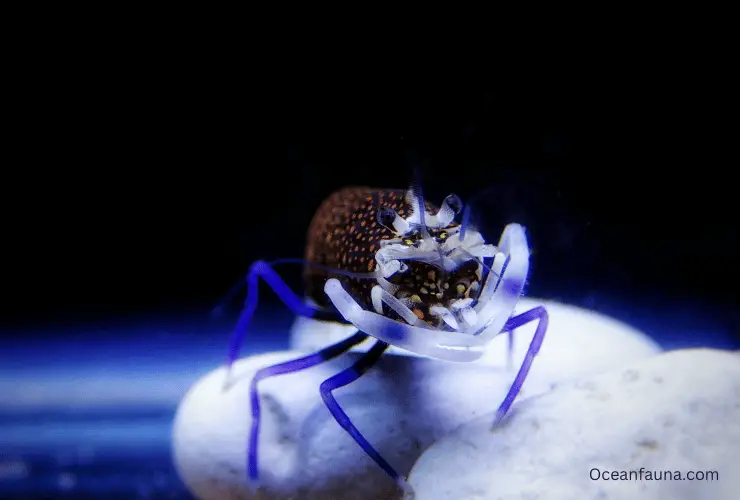After hearing the name bumble bee, what comes to your mind? You are correct if it is a small, yellow-and-black striped insect. But did you know there is another type of bumble bee as well, one that lives underwater and is not an insect? It’s the Bumblebee Shrimp!
The Bumble Bee Shrimp, or Striped Harlequin Shrimp, can be found all over the Indo-Pacific. These tiny shrimp only grow up to 1 inch in size and have yellow or white bodies with black stripes, making them resemble bumblebees.
People have many questions about shrimp, and I will provide answers and descriptions in this article.
About: Bumble Bee Shrimp
The Bumble Bee Shrimp, scientifically named Gnathophyllum americanum, can be found mostly in the tropical waters of the Indo-Pacific region. They prefer to live in rocky crevices and coral reefs, where they can hide from predators and find food.
These shrimp are omnivorous, meaning they eat both plants and animals. They primarily feed on small crustaceans, plankton, and algae. Bumble Bee Shrimp are also known to scavenge for food, feeding on dead animals and decaying matter.
One interesting fact about bumble bee Shrimp is that they have a symbiotic relationship with certain species of sea urchins. The shrimp will clean the urchins by removing algae and other debris from their spines, while the urchins protect the shrimp from predators.
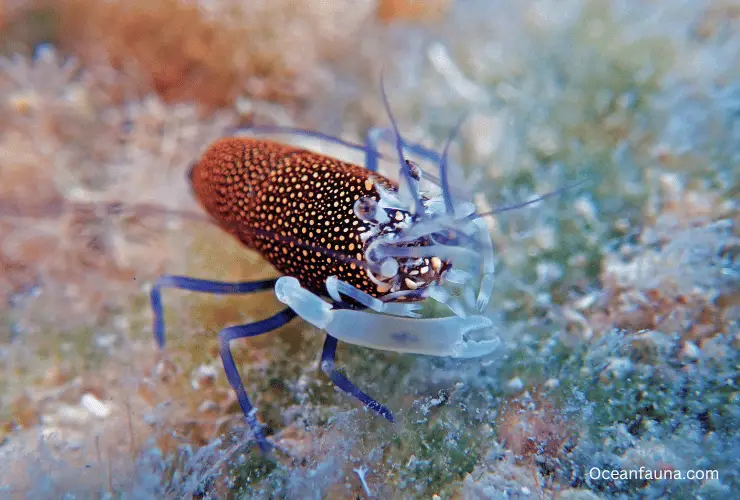
Like other shrimps, bumble bee Shrimp has the unique characteristic of being protandrous hermaphrodites, meaning they start their adult life as males and later become females for the rest of their lives.
| Category | Information |
| Scientific name | Gnathophyllum americanum |
| Other name | Striped Harlequin Shrimp |
| Diet | Omnivorous, feeds on algae, detritus, and small organisms |
| Habitat | Salt water – commonly found at Indo-Pacific region |
| Length | Up to 1 inch (2.5 cm) |
| Lifespan | 2-3 years |
| Interesting Fact | Bumble bee shrimp are known for their striking yellow and black stripes, which mimic the pattern of a bumblebee |
Anatomy of Bumble Bee Shrimp
The anatomy of bumble bee shrimp is complex and fascinating, consisting of various body systems and structures. Here are the details.
External Anatomy
The external anatomy of bumble bee shrimp is characterized by its colorful and striking appearance, which differs depending on the species. The shrimp’s body is divided into three main sections: head, thorax, and abdomen.
The head contains the eyes, antennae, mouthparts, and rostrum, while the thorax has five pairs of legs, with the first pair modified as claws or chelipeds.
The abdomen is divided into six segments, with the tail fan being the last segment. Bumblebee shrimp have a soft exoskeleton that protects their bodies.
Internal Anatomy
The internal anatomy of bumblebee shrimp is more complex and consists of different organs and systems that help in their survival and reproduction.
- The digestive system is composed of various organs, including the stomach, intestine, hepatopancreas, and digestive gland, which aid in the digestion of food.
- The circulatory system consists of a heart that pumps hemolymph, a type of blood, throughout the body.
- The respiratory system comprises gills present in the thoracic chamber, which helps in oxygen uptake.
- The nervous system is composed of the brain, which controls the shrimp’s behavior and movements.
Behavioral Anatomy
The behavioral anatomy of bumblebee shrimp encompasses all the behaviors and movements exhibited by the species.
Bumblebee shrimp are known for their ability to move quickly and dart around in the water. They use their chelipeds to capture prey, such as small fish, crustaceans, and worms.
They also exhibit different social behaviors, such as courtship, aggression, and territoriality. Some species, such as the red bumblebee shrimp, are known for their ability to communicate through sound.
Where Do Bumblebee Shrimp Live?
Bumblebee shrimp are mainly found in the eastern Atlantic, with their distribution extending to Bermuda, India (specifically at Landfall Island in North Andaman), and to the Indo-West Pacific region, stretching from the Red Sea all the way to Japan, Australia, and Oceania.
These shrimp live in subtidal, sublittoral, infralittoral, and deep ocean zones, occupying a habitat that ranges from the lower limit of the intertidal zone to the shelf edge, which is approximately 200 meters in water depth.
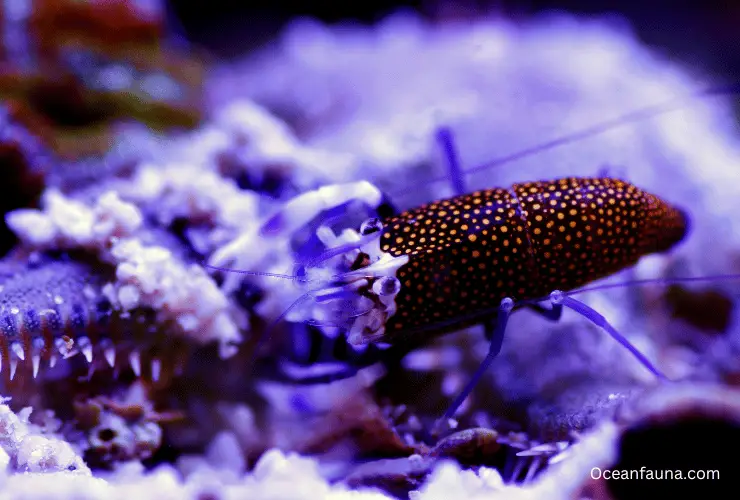
The subtidal zone, also known as the sublittoral zone, is the area between the low tide and the continental shelf’s edge, where bumblebee shrimp reside comfortably in pockets of rocky crevices and coral reefs.
The infralittoral zone is the area between the low tide mark and up to 30 meters in depth, characterized by large rock formations and kelps.
On the other hand, the deep ocean zone is an ecosystem that exists from a depth of 200 meters and beyond, where there is no sunlight or plant growth. Bumblebee shrimp are capable of residing in this zone as well, with their adaptability allowing them to thrive in the dark abyss.
Can Bumblebee Shrimps Live in An Aquarium?
Yes, bumblebee shrimps can indeed be kept in aquariums, specifically saltwater aquariums. However, they are a species that requires particular care to thrive. As such, several key factors are to consider when setting up an aquarium for bumblebee shrimp.
One of the most important aspects to consider is tank size. Bumblebee shrimp require a minimum tank size of at least 20 gallons in order to thrive. This provides them with enough space to move around and helps maintain the proper water parameters required for their survival.
Another vital factor to consider is water quality. Bumblebee shrimp cannot tolerate high nitrates or copper levels, and it is crucial to ensure that the iodine levels in the water remain correct and consistent. Failure to maintain proper water parameters may lead to extreme health issues and even death.
In terms of habitat and environment, the bumblebee shrimp requires some live rock in their aquarium. This live rock provides them with a suitable habitat and a place to retreat when they feel threatened or need privacy. Moderate lighting is also recommended in order to provide easy viewing and mimic their natural environment.
Always keep bumblebee shrimp in pairs to ensure their well-being and reduce stress levels. This also adds to the aesthetic appeal of the aquarium. However, it is important to note that they are not social creatures and tend to be solitary in the wild.
What Do Bumblebee Shrimp Eat?
Bumblebee shrimp are known to have a varied diet, as they are omnivorous in nature. Their diet essentially comprises both plant and animal-based food sources.
In the wild, these shrimp primarily feed on small crustaceans, plankton, and algae. They also scavenge for food and feed on dead animals and decaying matter. This scavenging behavior is beneficial for maintaining the cleanliness of their habitat.
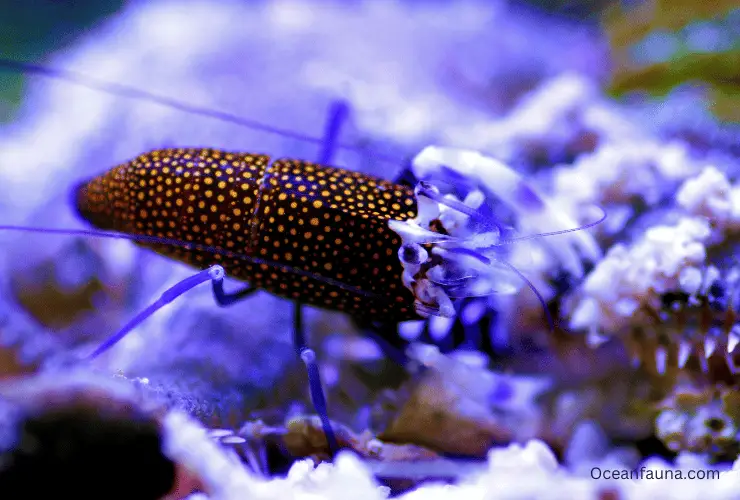
In an aquarium environment, bumblebee shrimp can be fed frozen meaty foods such as brine or mysis shrimp, cockle, or small pieces of fish. These foods can be offered to the shrimp on a daily basis.
In addition to their primary food sources, they also feed on the tube feet of echinoderms, although this is not a necessary component of their diet for survival.
While these shrimp are relatively easy to feed, their diet should still be varied and nutritious. To promote a healthy and active lifestyle, their food sources should be diverse and regularly supplemented with vitamins and minerals to ensure that they receive all the essential nutrients.
Bumblebee shrimp can thrive and contribute to a vibrant aquarium ecosystem with proper care and feeding.
How Long Do Bumble Bee Shrimp Live?
Bumblebee shrimp usually have a 2-3 years lifespan, which may differ based on several factors like water quality, diet, and overall care. When given appropriate care and a healthy setting, some bumblebee shrimp may live up to 5 years in captivity.
Like all living creatures, Bumblebee shrimp require a specific set of environmental conditions to thrive. They prefer a well-established aquarium with plenty of hiding spaces and water that is consistently kept between 72-78 degrees Fahrenheit.
They also require a balanced diet that includes a variety of foods, such as algae-based pellets, frozen brine shrimp, and other small crustaceans.
How Do Bumble Bee Shrimp Reproduce?
The reproduction process is the same for almost all the shrimps. Bumble bee shrimp reproduce through a fascinating process involving molting, mating, and egg-laying. After molting, the female shrimp will mate with a male shrimp at a right angle.
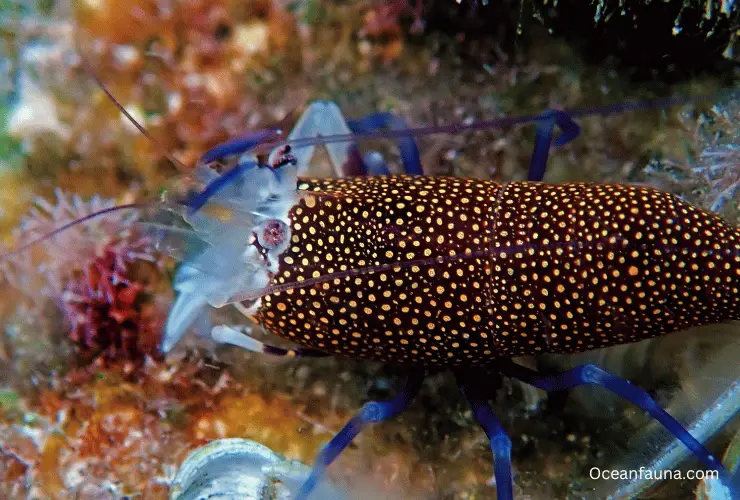
The male will transfer a spermatophore to a specialized receptacle on the female’s abdomen during this process. After that, the female shrimp will produce many eggs within six to 20 hours of mating.
However, bumble bee shrimp have unique characteristics that make their reproduction process even more interesting. They are protandrous hermaphrodites, which means that they are first male and then later become female. This transformation usually occurs during the second year of their life cycle.
After the transformation, the mature female bumble bee shrimp will move the eggs from her saddle, which is located behind the head, to the swimmerets, which are the back legs. She will then fan the eggs vigorously for about 30 days until they hatch into miniature shrimp.
During this period, the female shrimp will diligently care for the eggs by providing sufficient oxygen and protection against predators.
Relation Between Human and Bumble Bee Shrimp
The relationship between humans and bumble bee shrimp can vary depending on the context and purpose of keeping or consuming these small crustaceans.
For aquarium enthusiasts, bumble bee shrimp can be a fascinating addition to their collection. These shrimp are known for their peculiar yellow and black striped pattern resembling a bumblebee.
They are relatively easy to care for and can live in various tank conditions. Some people find joy in watching these shrimp scavenge for food, socialize with each other, and molt their exoskeletons.
On the other hand, bumble bee shrimp are also considered a popular seafood dish in some parts of the world. They are harvested from their natural habitat or grown in aquaculture farms and sold in markets and restaurants. The meat of a bumble bee shrimp is tender and succulent and can be cooked in various ways, including steaming, grilling, or stir-frying.
It is worth noting, however, that overfishing and habitat destruction can pose a threat to bumble bee shrimp populations. This is particularly problematic for those who rely on these shrimp for sustenance or income.
Sustainable fishing practices and conservation efforts can help ensure these creatures’ survival while supporting the livelihoods of those who depend on them.
Are Bumblebee Shrimp Rare?
To date, bumblebee shrimp are not considered rare. In fact, the International Union for Conservation of Nature (IUCN) has not even listed this species under their red list category. This means that the bumblebee shrimp is not endangered or threatened in any way.
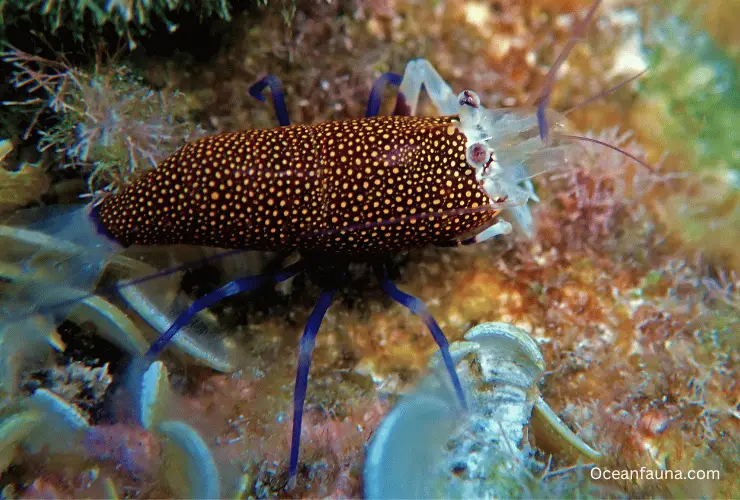
Furthermore, the bumblebee shrimp is a very common shrimp species in the Indo-Pacific Oceanic region. This area is known for its rich aquatic life and diverse marine species. The bumblebee shrimp, with its distinctive yellow and black striped appearance, can often live amongst coral reefs, rocky outcrops, and sandy areas throughout the region.
While the bumblebee shrimp may not be considered rare, they do play an important role in their ecosystem. As omnivorous scavengers, they help to clean up and recycle organic matter in their environment. This helps to maintain the overall health and balance of the marine ecosystem they inhabit.
Conclusion
Hopefully, now you have compact information about bumble bee shrimp. This unique species is a popular addition to any aquarium, and their tidy scavenging habits can help keep the tank clean.
With proper care and feeding, bumblebee shrimp can live for several years in captivity. If you want to know more about them, you may comment below.

